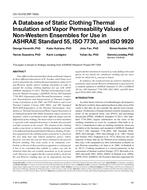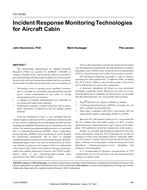-
-
Available Formats
- Options
- Availability
- Priced From ( in USD )
-
Available Formats
-
- Immediate download
- $16.00
- Add to Cart
Customers Who Bought This Also Bought
-

CH-15-018 -- (RP-1504) A Database of Static Clothing Ther...
Priced From $16.00 -

CH-15-022 -- Incident Response Monitoring Technologies fo...
Priced From $16.00 -

CH-15-005 -- (RP-1499) Dependence of ESD Charge Voltage o...
Priced From $16.00 -

CH-15-030 -- Improvement of Building Energy Simulation Ac...
Priced From $16.00
About This Item
Full Description
This paper investigates the two methods used in determining the point of airflow stabilization in a fan-duct connection system, known as the effective duct length equations. Two methods, widely used in the industry, are a standard-based equation and the number of diameters rule. The two methods were assessed by comparing the velocity and pressure results in the air duct system. An industry-standard centrifugal fan was used as the basis of the analysis. The methodology employed was using a computational fluid dynamics (CFD) software package to model the system.
Airflow stream lines and airflow pressure contours were recorded. Data were collectedandtabulated for analysis.Graphsweregenerated for discussions. This paper discusses the development of a mathematical pressure-mean air-velocity relationship. The results collected confirmed the following:
- The two methods used to determine the effective duct length--standard-based equation and number of diameters rule--are in agreement.
- The effective duct length criteria can be judged by air velocity measurements when positioning the air velocity sensor at the top part of the air duct.
- For pressure measurements, analysis has shown that it is possible to obtain the pressure values by using the mean air velocity measurements taken at the 100% effective duct length position, thus eliminating the need to install pressure sensors and rely on air velocity sensors for velocity and pressure measurements.
In conclusion, CFD techniques can be used to improve the accuracy of airflow stabilization in an air duct system. Measurement and control instruments can be positioned and calibrated effectively, therefore improving the performance of fan-air duct systems by reducing fan energy with accurate measurement and controlsystems.Thispaperdemonstrateshowthe velocitysensors can also be used to determine pressure levels in the air duct, removing the need to install pressure sensors in air ducts. One static pressure sensor installed in a building can be used to obtain static pressure. Signals from the velocity sensors in air ducts and the static pressure sensorcanbefed intoacentralcomputerbuildingmanagement system to obtain pressure levels in air ducts.This presents a saving in materials and installation costs.





